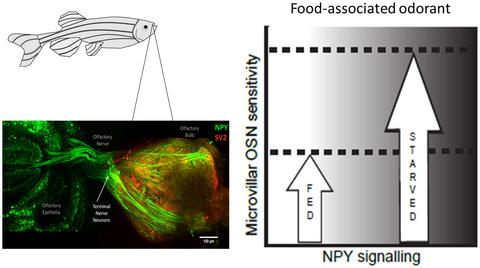当前位置:
X-MOL 学术
›
J. Neurochem.
›
论文详情
Our official English website, www.x-mol.net, welcomes your feedback! (Note: you will need to create a separate account there.)
Sensitivity of olfactory sensory neurons to food cues is tuned to nutritional states by Neuropeptide Y signaling
Journal of Neurochemistry ( IF 4.7 ) Pub Date : 2021-08-06 , DOI: 10.1111/jnc.15488 Tarun Kaniganti 1 , Ajinkya Deogade 1 , Aditi Maduskar 1 , Arghya Mukherjee 1 , Akash Guru 1 , Nishikant Subhedar 1 , Aurnab Ghose 1
Journal of Neurochemistry ( IF 4.7 ) Pub Date : 2021-08-06 , DOI: 10.1111/jnc.15488 Tarun Kaniganti 1 , Ajinkya Deogade 1 , Aditi Maduskar 1 , Arghya Mukherjee 1 , Akash Guru 1 , Nishikant Subhedar 1 , Aurnab Ghose 1
Affiliation

|
Modulation of sensory perception by homeostatic feedback from physiological states is central to innate purposive behaviors. Olfaction is an important predictive modality for feeding-related behaviors and its modulation has been associated with hunger-satiety states. However, the mechanisms mapping internal states to chemosensory processing in order to modify behavior are poorly understood. In the zebrafish olfactory epithelium, a subset of olfactory sensory neurons (OSNs) and the terminal nerve projections express neuropeptide Y (NPY). Using a combination of neuronal activity and behavioral evaluation, we find that NPY signaling in the peripheral olfactory system of zebrafish is correlated with its nutritional state and is both necessary and sufficient for the olfactory perception of food-related odorants. NPY activity dynamically modulates the microvillar OSN activation thresholds and acts cooperatively with amino acid signaling resulting in a switch-like increase in OSN sensitivity in starved animals. We suggest that cooperative activation of phospholipase C by convergent signaling from NPY and amino acid receptors is central to this heightened sensitivity. This study provides ethologically relevant, physiological evidence for NPY signaling in the modulation of OSN sensitivity to food-associated amino acid cues. We demonstrate sensory gating directly at the level of OSNs and identify a novel mechanistic framework for tuning olfactory sensitivity to prevailing energy states.
中文翻译:

嗅觉感觉神经元对食物线索的敏感性通过神经肽 Y 信号传导调节到营养状态
通过生理状态的稳态反馈调节感官知觉是先天有目的行为的核心。嗅觉是喂养相关行为的重要预测方式,其调节与饥饿-饱腹状态有关。然而,人们对将内部状态映射到化学感应处理以改变行为的机制知之甚少。在斑马鱼嗅觉上皮细胞中,嗅觉感觉神经元 (OSN) 的一个子集和末端神经投射表达神经肽 Y (NPY)。结合神经元活动和行为评估,我们发现斑马鱼外周嗅觉系统中的 NPY 信号传导与其营养状态相关,对于食物相关气味的嗅觉感知是必要和充分的。NPY 活性动态调节微绒毛 OSN 激活阈值,并与氨基酸信号传导协同作用,导致饥饿动物 OSN 敏感性的开关样增加。我们建议通过来自 NPY 和氨基酸受体的会聚信号协同激活磷脂酶 C,这是提高敏感性的核心。这项研究为 NPY 信号传导在调节 OSN 对食物相关氨基酸线索的敏感性方面提供了行为学相关的生理学证据。我们直接在 OSN 水平上展示了感觉门控,并确定了一种新的机制框架,用于调整嗅觉对主要能量状态的敏感性。我们建议通过来自 NPY 和氨基酸受体的会聚信号协同激活磷脂酶 C,这是提高敏感性的核心。这项研究为 NPY 信号传导在调节 OSN 对食物相关氨基酸线索的敏感性方面提供了行为学相关的生理学证据。我们直接在 OSN 水平上展示了感觉门控,并确定了一种新的机制框架,用于调整嗅觉对主要能量状态的敏感性。我们建议通过来自 NPY 和氨基酸受体的会聚信号协同激活磷脂酶 C,这是提高敏感性的核心。这项研究为 NPY 信号传导在调节 OSN 对食物相关氨基酸线索的敏感性方面提供了行为学相关的生理学证据。我们直接在 OSN 水平上展示了感觉门控,并确定了一种新的机制框架,用于调整嗅觉对主要能量状态的敏感性。
更新日期:2021-08-06
中文翻译:

嗅觉感觉神经元对食物线索的敏感性通过神经肽 Y 信号传导调节到营养状态
通过生理状态的稳态反馈调节感官知觉是先天有目的行为的核心。嗅觉是喂养相关行为的重要预测方式,其调节与饥饿-饱腹状态有关。然而,人们对将内部状态映射到化学感应处理以改变行为的机制知之甚少。在斑马鱼嗅觉上皮细胞中,嗅觉感觉神经元 (OSN) 的一个子集和末端神经投射表达神经肽 Y (NPY)。结合神经元活动和行为评估,我们发现斑马鱼外周嗅觉系统中的 NPY 信号传导与其营养状态相关,对于食物相关气味的嗅觉感知是必要和充分的。NPY 活性动态调节微绒毛 OSN 激活阈值,并与氨基酸信号传导协同作用,导致饥饿动物 OSN 敏感性的开关样增加。我们建议通过来自 NPY 和氨基酸受体的会聚信号协同激活磷脂酶 C,这是提高敏感性的核心。这项研究为 NPY 信号传导在调节 OSN 对食物相关氨基酸线索的敏感性方面提供了行为学相关的生理学证据。我们直接在 OSN 水平上展示了感觉门控,并确定了一种新的机制框架,用于调整嗅觉对主要能量状态的敏感性。我们建议通过来自 NPY 和氨基酸受体的会聚信号协同激活磷脂酶 C,这是提高敏感性的核心。这项研究为 NPY 信号传导在调节 OSN 对食物相关氨基酸线索的敏感性方面提供了行为学相关的生理学证据。我们直接在 OSN 水平上展示了感觉门控,并确定了一种新的机制框架,用于调整嗅觉对主要能量状态的敏感性。我们建议通过来自 NPY 和氨基酸受体的会聚信号协同激活磷脂酶 C,这是提高敏感性的核心。这项研究为 NPY 信号传导在调节 OSN 对食物相关氨基酸线索的敏感性方面提供了行为学相关的生理学证据。我们直接在 OSN 水平上展示了感觉门控,并确定了一种新的机制框架,用于调整嗅觉对主要能量状态的敏感性。


























 京公网安备 11010802027423号
京公网安备 11010802027423号